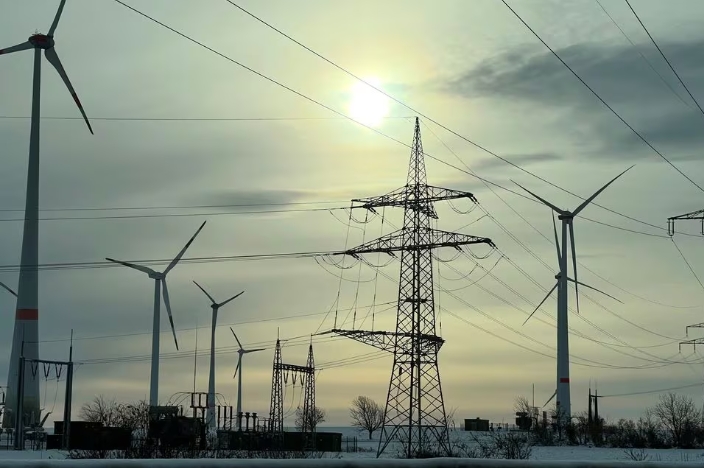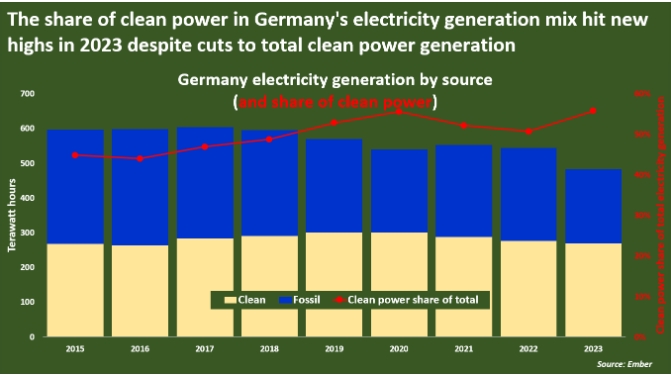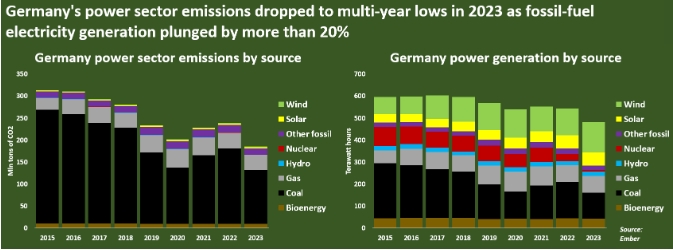
Coal-fired electricity generation dropped by nearly 30%, while electricity output from all fossil fuel sources shrank by over 20% to ensure that 2023 will enter the record books in terms of the clean power share of Europe's largest economy.
However, enduring output cuts across several key industries - especially in chemicals and fertilizers - potentially flattered Germany's power profile in 2023 by cutting electricity use among traditionally highly energy intensive sectors.
A more accurate read on the true extent of Germany's energy transition momentum away from fossil fuels may emerge in 2024, as new fixed power cost deals for businesses kick in and potentially boost total electricity demand in the country.
FOSSIL CUTS VS CLEAN POWER GAINS
The share of clean power in Germany's electricity mix hit a record 55.8% in 2023, compared to 50.7% in 2022 and an average of 47.5% from 2015 through 2020, Ember data shows.

The share of clean power in Germany's electricity generation mix hit new highs in 2023 despite cuts to total clean power generation
That gain in the proportion of clean power flows across Germany's electricity grids suggests power producers have rapidly expanded the supply of clean power.
However, total clean electricity generation in 2023 actually declined by 2.4% from the total seen in 2022, and at 269 terawatt hours (TWh) was the lowest cumulative sum of clean electricity generated in Germany since 2016.
A key driver behind the stunted clean power output levels was the shuttering of Germany's last remaining nuclear power reactors in early 2023, which resulted in a roughly 80% drop in total nuclear generation from the year before.

Germany's power sector emissions dropped to multi-year lows in 2023 as fossil-fuel electricity generation plunged by more than 20%
Record generation from wind and solar sources (139 TWh and 60 TWh respectively), as well as the highest hydro output in a decade (20.32 TWh), helped offset most but not all of the decline seen in nuclear output.
Yet despite the year-on-year decline, total clean electricity generation still exceeded the 213 TWh of electricity produced from fossil fuel sources in 2023, thereby pushing clean power's share of the total generation mix to new highs.
RECOVERING DEMAND?
Expanded clean power generation capacity - which grew by a record 14 gigawatts (GW) from solar sites and 6.4 GW from wind sites in 2023 - should help boost total German clean power generation further in 2024.
But the main determinant of the overall clean/fossil generation balance in 2024 will be the level of total electricity and power demand in the country.
Particularly important will be demand from Germany's massive industrial sector, especially its chemicals and fertilizer producers which have operated at well below capacity since Russia's invasion of Ukraine in early 2022 severed natural gas flows to Germany's power system.
While power prices have pulled back from the record peaks scaled around mid-2022 following the gas supply cuts, average German wholesale power prices in 2023 remained nearly twice their average from 2019 through 2021, data from LSEG shows.
In response to growing concerns about the economic impact of a sustained industrial downturn, Germany's government and industrial groups agreed in November on a package of measures designed to reduce power prices for key businesses and spur a return to growth in 2024.
Should those measures prove effective and trigger increases in output throughout Germany's industrial supply lines, total energy consumption in the country will also increase.
Given the increases in renewable energy capacity in 2023, power producers will have scope to lift clean power generation to new highs to meet some of that additional energy use.
But if heavy industry and factories simultaneously lift their collective electricity use then power firms will also likely need to boost output from fossil fuels.
Higher fossil fuel output may in turn reduce clean power's share of the electricity mix back towards previous levels.